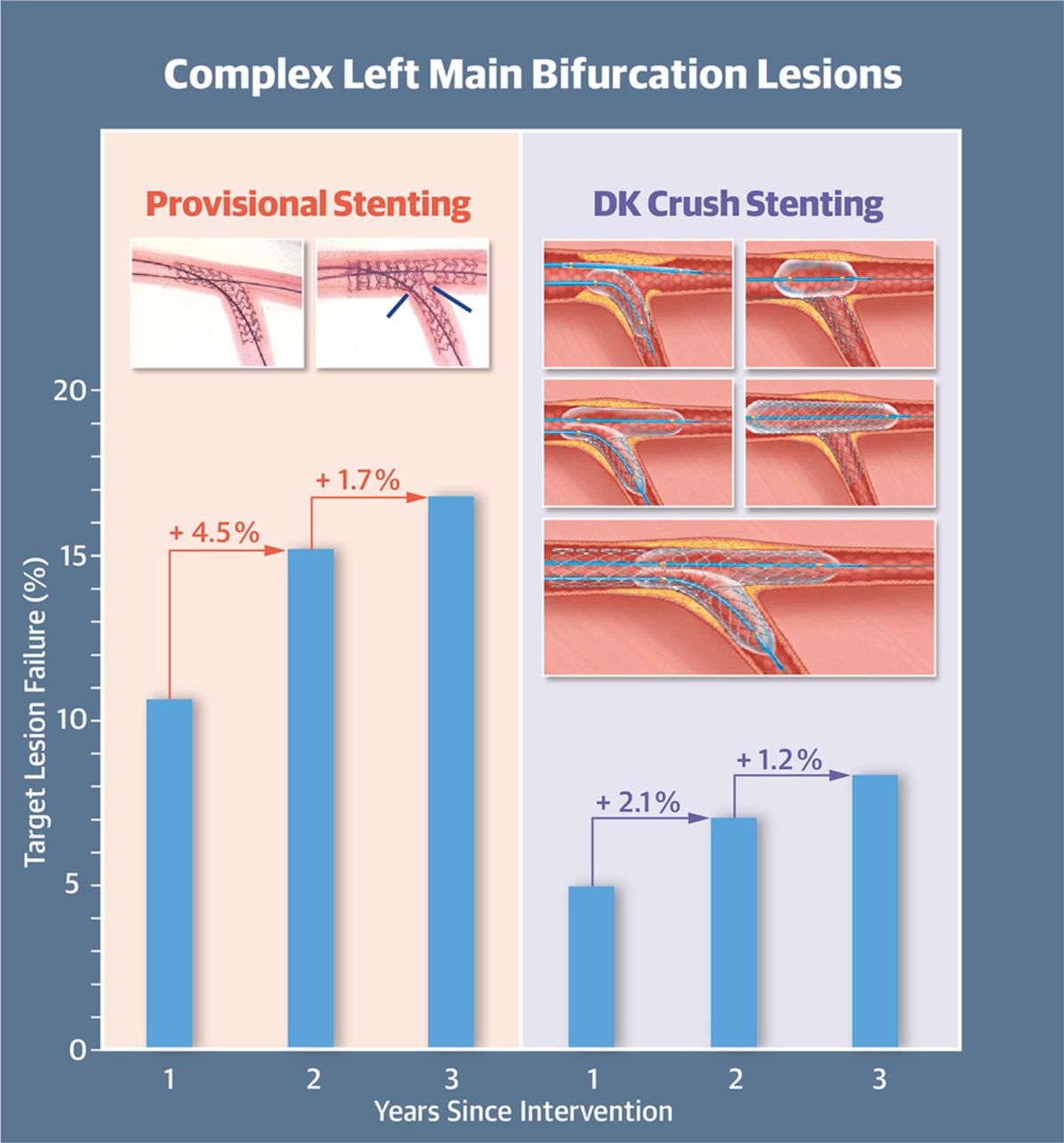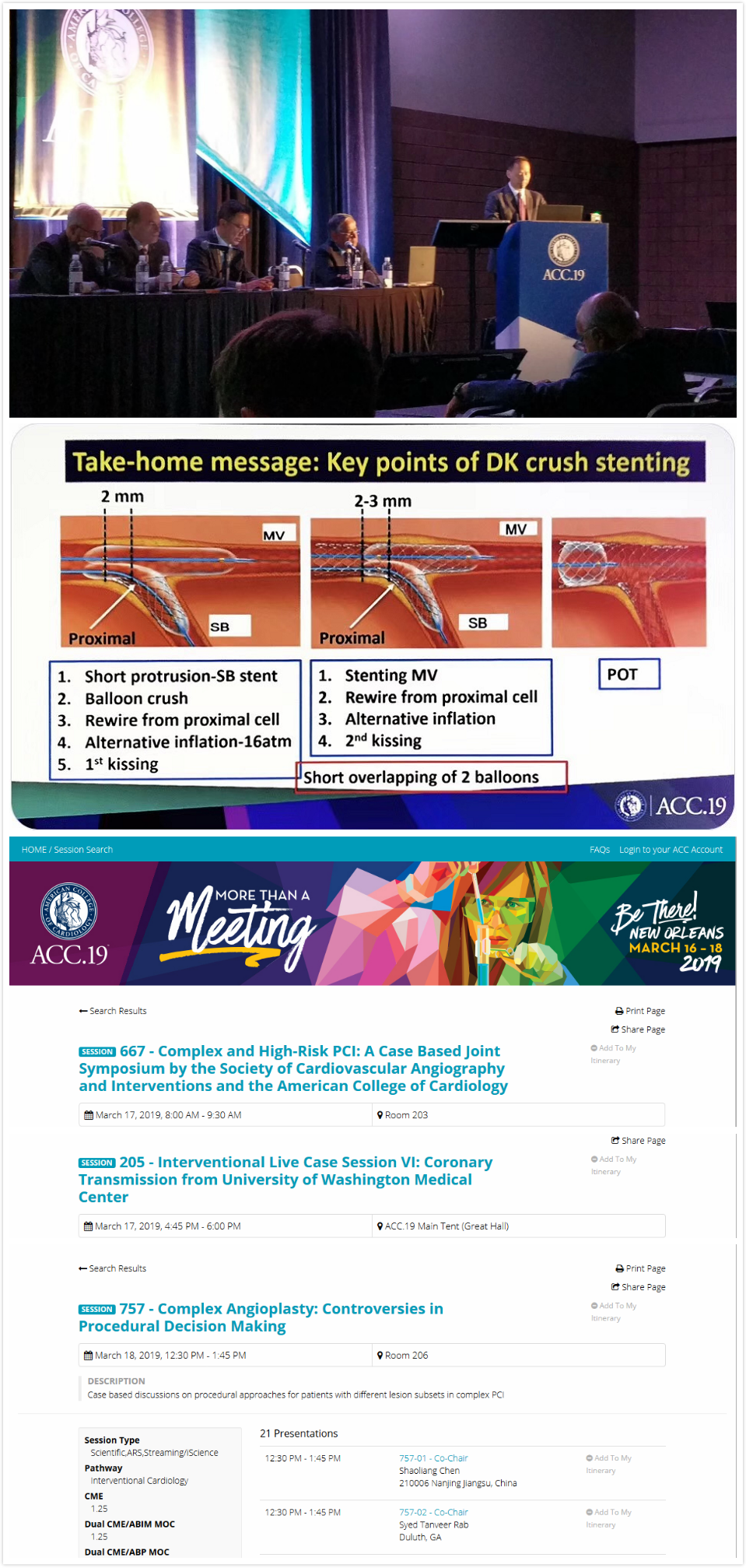


-
-
Scientific LibraryAcute Coronary Syndrom ASCVD Prevention Bifurcation Stenting Cardio-Oncology Congestive Heart Failure DAPT Duration Drug Coated Balloon Fractional Flow ReserveNewsCases VideosE-LearningIndustry Insights
- LIVE
-
 Article Link
Article Link

DK CRUSH Study Series Newest Updates - 3 Year Outcome of DK Crush vs Provisional Stenting
CBSMD
How to Perform DK Crush Technique?
On November 13th, 2019, DK Crush Technique and technical details were introduced by Prof. Shao-Liang Chen by ACC, the inventor of this transcatheter technique for left main and non-left main bifurcation lesions. Step by step were demonstrated in "Left Main Stenting: What We Have Learnt So Far? ".
Newest Release at TCT 2019

PI of DK CRUSH V, Prof. Shao-liang Chen and research colleagues at TCT 2019

DK CRUSH V 3 Year Outcome:
At 3 years, TLF occurred in 41 (16.9%) patients in the PS group and in 20 (8.3%) patients in the DK group (p = 0.005), mainly driven by increased target vessel myocardial infarction (5.8% vs. 1.7%; p = 0.017) and target lesion revascularization (10.3% vs. 5.0%; p = 0.029). Definite or probable ST rate at 3 years was 4.1% in the PS group and 0.4% in the DK group (p = 0.006). Notably, DK crush was associated with a significant reduction in both primary and secondary endpoints for patients with complex lesions or at high risk. Provisional stenting for UPLMb lesions was associated with significantly increased rates of TLF and ST over 3 years of follow-up. Further randomized study is warranted to confirm the benefits of DK crush stenting for complex UPLMb lesions. (Double Kissing and Double Crush versus Provisional T Stenting Technique for the Treatment of Unprotected Distal Left Main True Bifurcation Lesions: A Randomized, International, Multi-center Clinical Trial; ChiCTR-TRC-11001213).
In a joint review written by Nicola Ryan and Dejan Milasinovic published on PCRonline Journal Club, the authors shared their comments on DK Crush V 3 year outcome:
Why this study – the rationale/objective? - In non-LM bifurcations, provisional stenting is considered the standard approach in the majority of cases. DKCRUSH-V, the first published randomised control trial of provisional versus 2-stent technique in true left main bifurcation lesions, showed lower rates of target lesion failure (TLF) at one year in the DKCRUSH arm (5.0% vs. 10.7%, p=0.02), mainly driven by increased rates of target vessel MI. In this paper, the authors report the extended follow-up to three years.
How was it executed – the methodology? - DKCRUSH-V included patients undergoing PCI for symptoms or proven ischemia with an unprotected true LM bifurcation stenosis (Medina 1,1,1 or 0,1,1). 72.2% of the enrolled patients presented with unstable angina.
- - The primary endpoint was TLF (a composite of cardiac death, target vessel MI, or clinically driven TLR) at 3 years, with a safety endpoint of stent thrombosis.
- - In order to include patients in the trial, operators must have performed ≥300 PCI/year for 5 years with ≥20 LMS/year, with 3-5 DK Crush cases submitted for assessment by the steering committee.
What is the main result? - DKCRUSH-V randomised 482 patients, 240 to DK Crush and 242 PS, none of whom were lost to follow up during the three years. Among these patients, 196 (108 in the DK group) had complex lesions according to the DEFINITION Criteria, there were similar numbers of patients with SYNTAX Scores >32 and NERS II Score >19 in the PS and DK groups (36.4% vs 37.9%, p=0.72, and 41.7% vs. 47.9%, p=0.17, respectively).
-
- TLF was significantly higher in the PS group compared to the DK group (16.9% vs. 8.3%, p=0.005), mainly driven by TLR (10.3% vs. 5.0%, p=0.029) and TVMI (5.8% vs. 1.7%, p=0.017).
-
- Prior to three years the TLF was driven by target vessel MI with TLR only emerging at three-year follow-up.
-
- Rates of definite and probable stent thrombosis were also higher in the PS group (4.1% vs. 0.4%, p=0.006) – all ST occurred in patients on DAPT, with none after 1 year in the DK group.
-
- In patients with NERS II Score <19 or SYNTAX Scores <32 there was no significant difference in TLF rates at three years (PS 15.3% vs DK 8.9% p=0.08).
-
- In comparison, in patients with complex disease, as documented by NERS II Score >19 or SYNTAX Score >32, there were increased rates of TLF in the PS group (20.0% vs. 7.3% p=0.029), with numerically but not statistically higher rates of TVMI and TLR (7.1% vs. 1.2%, p=0.102 and 10.6% vs. 4.9%, p=0.206 respectively).
-
- Of note, 47.1% of the PS group required an SB stent for suboptimal results, with lower rates of final kissing balloon inflation in the PS group (78.9% vs. 99.6%, p<0.001).
-
- At three years approximately, ¾ of all patients remained on DAPT.
Critical reading and relevance for clinical practice
The results of this study show that the DK crush strategy remains superior to a provisional strategy at three years follow-up in true unprotected distal left main bifurcations. Patients with high anatomic complexity as defined by NERS II or SYNTAX Scores appear to benefit more from DK Crush than those with less complex lesions.
A note of caution when interpreting the results, one must bear in mind that operators were committed high volume DK crush operators, which may limit the generalisability of the results as DK Crush requires training and experience to gain expertise. The left main disease in DKCRUSH-V was complex with long segments of disease in the LCx (mean 16mm), which may be in line with the previously published DEFINITION study (Chen et al. JACC Cardiovasc Interv. 2014 Nov;7(11):1266-76.), where 2-stent strategies showed potential benefits in patients with complex bifurcations.
In summary, DKCRUSH-V adds to the evidence that an upfront 2-stent strategy may be most appropriate in selected patients with complex underlying anatomy, when carried out by experienced operators. The ongoing EBC MAIN trial will further enhance the evidence in this area.


Prof. Ruilin Gao presented and highlighted the recommended interventional technique DK Crush for treating left main true bifurcation lesions at CIT 2019 in Beijing.
Prof. Shao-liang Chen gave a thorough analysis on " Why was the superority of provisional stenting to 2-stent not recorded in serial DKCRUSH studies".


Prof. Shao-liang Chen presented DK-Crush Technique at ACC.19 in New Orleans.


http://www.cbsmd.cn Contact us by cbs@cbsmd.cn
Copyright ⓒ CBSMD Nanjing China. All rights reserved.



